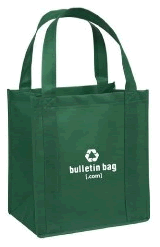 BOTTOM LINE for those in a hurry:
BOTTOM LINE for those in a hurry:
• The best bags are ones you already have. Reuse them. (I had accumulated about 15 reusable bags over the years, mostly as swag from conferences. If you want to know which are the least harmful to the environment and why, read on.
• Refuse Single Use Plastic (SUP) bags when possible.
THE BACKSTORY:
I had been feeling rather virtuous about taking reusable bags with me when shopping. I knew that the thin single use plastic (SUP) bags that grocery stores usually use cannot be put in curbside recycling and most often end up as litter or worse – polluting the oceans and getting into the food chain through fish. Yes, our local grocery store (Kroger) has a large convenient bin to collect these bags but only 9% of plastic film is actually recycled. So, I was doing the right thing by using reusable bags. Or was I?
A friend sent me a disturbing article from the New York Times titled The Cotton Tote Crisis which explained that one would have to use a cotton bag 20,000 times to offset its overall impact on the environment (intensive use of water in growing the cotton, etc.) I was using at least 6 cotton bags. Hmmm. I needed to do some more research.
The deeper I got into the research the more complicated it got. The usual alternatives to cotton bags are: those evil single use film plastic bags, polypropylene bags, paper bags, and misc. bags made out of nylon like Baggu, hemp, or other fibers. Were they any better? Well, maybe.
SUMMARY OF REUSABLE BAG OPTIONS:
- Single Use Plastic (LDPE) Bags made of a thin plastic film – Since these are almost always SUPs (if you don’t use them to pick up dog poop) many grocery store chains will accept them for recycling.
- Polypropylene (PP) Bags – PPs are still a form of plastic but are more environmentally friendly than other plastics since they don’t release as many toxins as PVC and break down more quickly. PP has a low carbon footprint and transmits the lowest carbon dioxide emissions compared to other plastics. When burned, it does not generate toxic gases.
- Paper Bags – Are made from a renewable resource (usually trees) and are biodegradable, BUT can contribute to deforestation and excessive water use. Besides they are seldom used more than once (although I use the large grocery bags as kitchen garbage can liners which avoids using plastic there).
- Miscellaneous Bags – Hemp, jute (aka burlap), nylon/polyester, recycled material. Bulletin Bag (below) gives the most comprehensive descriptions of these options with pros & cons.
FURTHER ARTICLES comparing various reusable bags for the serious and industrious.
Plastic, Paper or Cotton: Which Shopping Bag is best?
(Columbia Climate School, 4-30-2020) Contains a lot of overview and background.
Sustainable Shopping – Which bag is best?
(National Geographic) Unbiased. Not trying to sell anything. Just the facts.
What material makes the best reusable bags?
(Bulletin Bag (800-273-5976) Produces promotional products; also offers hemp, jute, nylon, & polyester bags. Includes a handy chart of “advantages vs. disadvantages” for each type of material.
Your cotton tote is pretty much the worst replacement for a plastic bag
(Quartz 4-1-2019) Climate advocacy publication. Check out Quartz handy cumulative environmental impact chart.
The 10 Best Reusable Shopping Totes to Replace Plastic Bags
(Travel & Leisure, June 2021) Describes a variety of reusable bags but does not evaluate their environmental impact. Some are very fashionable. Many can be folded into tiny carrying packets.
So, I did the research but you have to make your decisions. If you don’t get enough free bags from conferences, contact me and I’ll tell you what I’d buy if I had to pay.